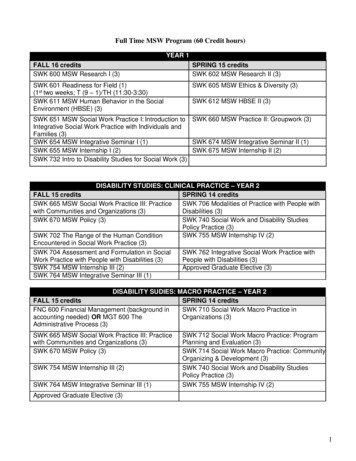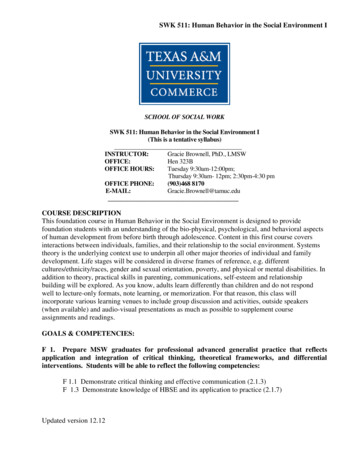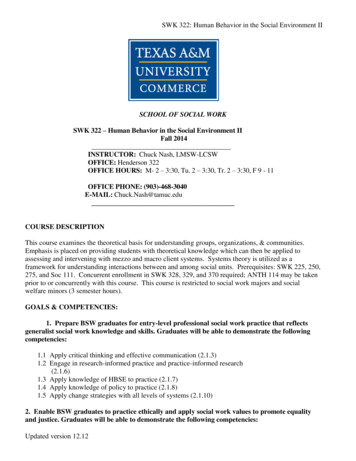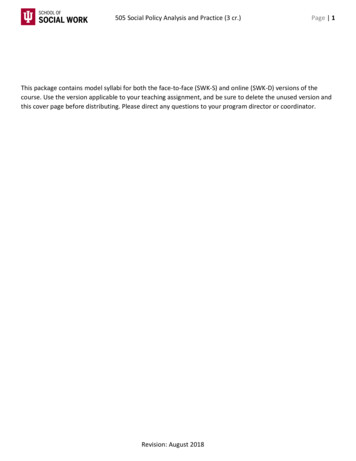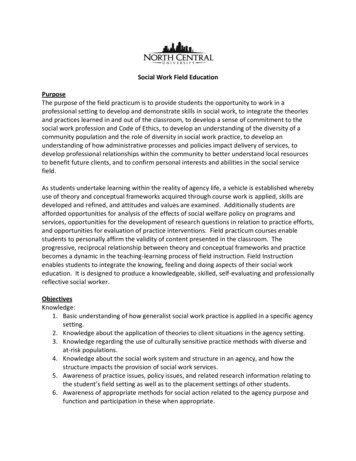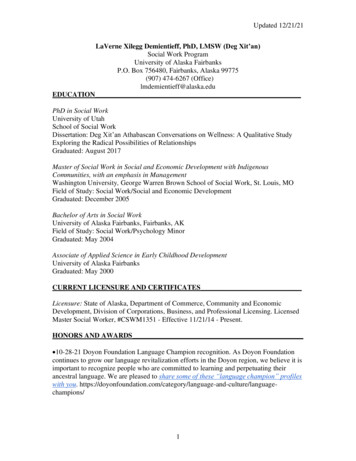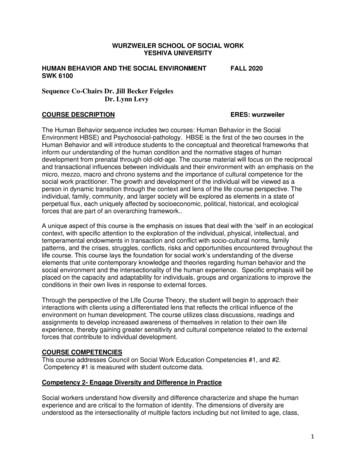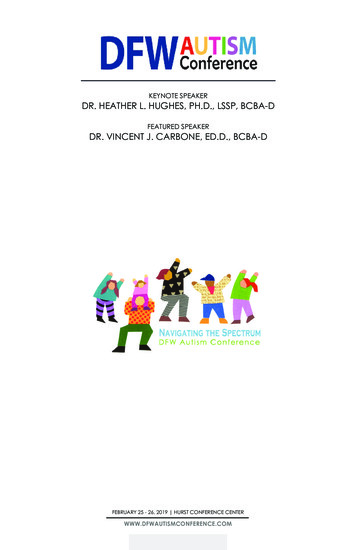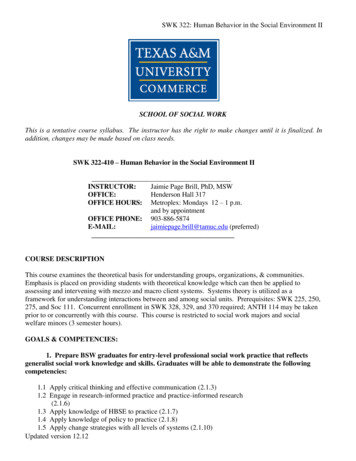
Transcription
SWK 322: Human Behavior in the Social Environment IISCHOOL OF SOCIAL WORKThis is a tentative course syllabus. The instructor has the right to make changes until it is finalized. Inaddition, changes may be made based on class needs.SWK 322-410 – Human Behavior in the Social Environment IIINSTRUCTOR:Jaimie Page Brill, PhD, MSWOFFICE:Henderson Hall 317OFFICE HOURS: Metroplex: Mondays 12 – 1 p.m.and by appointmentOFFICE PHONE: 903-886-5874E-MAIL:jaimiepage.brill@tamuc.edu (preferred)COURSE DESCRIPTIONThis course examines the theoretical basis for understanding groups, organizations, & communities.Emphasis is placed on providing students with theoretical knowledge which can then be applied toassessing and intervening with mezzo and macro client systems. Systems theory is utilized as aframework for understanding interactions between and among social units. Prerequisites: SWK 225, 250,275, and Soc 111. Concurrent enrollment in SWK 328, 329, and 370 required; ANTH 114 may be takenprior to or concurrently with this course. This course is restricted to social work majors and socialwelfare minors (3 semester hours).GOALS & COMPETENCIES:1. Prepare BSW graduates for entry-level professional social work practice that reflectsgeneralist social work knowledge and skills. Graduates will be able to demonstrate the followingcompetencies:1.1 Apply critical thinking and effective communication (2.1.3)1.2 Engage in research-informed practice and practice-informed research(2.1.6)1.3 Apply knowledge of HBSE to practice (2.1.7)1.4 Apply knowledge of policy to practice (2.1.8)1.5 Apply change strategies with all levels of systems (2.1.10)Updated version 12.12
HBSE II – FALL 20152. Enable BSW graduates to practice ethically and apply social work values to promote equalityand justice. Graduates will be able to demonstrate the following competencies:2.1 Apply social work ethics & principles (2.1.2)2.2 Engage diversity in practice (2.1.4)2.3 Promote human rights and social and economic justice (2.1.5)3. Provide meaningful contexts through which BSW students engage in leadership, service, andprofessional excellence. Graduates will be able to demonstrate the following competencies:3.1 Identify and respond as a professional social worker (2.1.1)3.2 Respond to professional contexts that shape practice,demonstrating qualities of leadership for the profession. (2.1.9)COURSE OBJECTIVES1. To reintroduce students to a systems paradigm for incorporating knowledge, theories, &methodologies for practice with groups, organizations, and communities.2. To present an overview of major theories related to groups, organizations, and communities tosupport macro practice.3. To assist students in synthesizing their understanding of social interactions within groups,organizations, and communities.4. To emphasize the impact of age, race, ethnicity, socioeconomic class, gender roles, & sexualorientation on interactions within & between groups, organizations, and communities.5. To enhance students’ awareness of social work principles, values, & ethics in relation toassessment and intervention strategies with diverse, disadvantaged, & oppressed populations ingroups, organizations, & communities.6. To assist students in analyzing the research base of theories & knowledge presented in the coursecontent to enhance their critical thinking skills.7. To encourage students’ awareness of their own attitudes & behaviors within their personal &professional environments.8. To promote knowledge of current human resource systems that is integral to the delivery of humanservices.STUDENT LEARNING OUTCOMES:1. Define and explore the macro social environment.2. Learn concepts involving values that characterize generalist practice.3. Explain major theoretical perspectives on groups.4. Identify basic concepts inherent in interpersonal group dynamics.5. Define task groups formed to meet client, organization, and community needs.Master Syllabus as of Fall 2011
HBSE II – FALL 20156. Demonstrate the application of ecosystems concepts to organizations and social agencies.7. Understand the impact of social and economic forces on social service organizations.8. Describe the importance of power in organizations and identify its various types.9. Explain problems frequently encountered by and in social service organizations.10. Understand the concept of community.11. Describe the importance of citizen participation and social support networks.12. Define neighborhoods and examine how they provide a vital context for human behavior.13. Describe how populations-at-risk can be empowered in the micro environment.14. Define human rights and understand the significance of concepts for international social workpractice.RELATIONSHIP TO OTHER COURSES: This course builds on HBSE I, with a focus on groups,neighborhoods, community, and global macro environments.TEXT: Kirst-Ashman, K. (2014). Human behavior in the macro social environment: An empowermentapproach to understanding communities, organizations, and groups (4th Ed.). Belmont, CA:Brooks/Cole.OVERVIEW OF ASSIGNMENTS:A. Social Problem Paper: (150 points)This paper (8 – 10 pages) will address a specific social problem that impacts human development and/orsocial functioning and includes a major macro component. Possible topics include: UnemploymentAIDSTeenage pregnancyWorking poorHomeless families or general homelessnessPovertyDomestic violenceOnce you have decided on a topic and received instructor permission: use the following as a guide tocompleting the paper:I.II.Using statistical data and scholarly literature, define the nature and parameters of the socialproblem and the populations most impacted by the problem, including information about thenature of the any consequences.Using a Conceptual Framework or Theories Concerning Groups (field theory, social exchangetheory, learning theory, cognitive-behavioral theory, psychoanalytic theory, systems theory,empowerment theory, and feminist theories), explain how the specific social problem is createdand/or maintained by communication, interpersonal interaction, norms, group cohesiveness, powerand status, leadership, and the social, economic, political, media, religious and any other macrolevel institutions or social arrangements in our society.Master Syllabus as of Fall 2011
HBSE II – FALL 2015III.Explain the social injustices and the oppressive forces that are implicated in the problem.IV.Suggest some social work strategies for prevention of and intervention with the problem at themacro level including family, community and institutional levels.V.Papers should include at least 5 appropriate sources. Sources can include one website; the othersources must be scholarly books, chapters in books, or articles from academic journals.VI.VII.If possible, you should attend a community event/activity related to your topic. You experience atthe community event and information gleaned from the event should be included in your paper.VIII.You can include handouts or information from the community event in an appendix.IX.You will need a brief introduction at the beginning of the paper; this introduction explains what thepaper is about. Then you will need headings for the rest of the paper, as described below.Use the following headings to write your paper. Failure to use headings will result in a grade ofzero for the assignment.a.b.c.d.e.f.X.Nature and Parameters of the Social ProblemTheoretical ApproachSocial Injustice and OppressionPrevention and InterventionCommunity Event/Activity (if appropriate)SummaryYou will need a cover page and a reference page that conform to appropriate APA style. Thesepages do not count in the total number of pages required for the paper. Do not put the paper in afolder. Just staple the top left corner.B. Community Organization Group Presentation: (100 Points)Students will form groups of 4 or 5 and provide class presentations regarding a specific community ororganization. Group members will be assigned by the professor and are to work collaboratively tothoroughly assess a community or organization, including strengths and areas of possible improvement.Students will be graded on their individual contribution to the final group product as well as the quality ofthe completed project. Each group member will conduct a confidential evaluation of the work of all othergroup members. The evaluations will be used by the professor to partially determine the grades ofindividual students. Group members who do not fully participate in the project will also incur a loweredproject grade. Students must be present during all of the class presentations to receive the points fromtheir Group Presentations. Presentation dates are: 11/23, 11/30, 12/7.Each member of the group will cover a specific element within the community or organization. Eachgroup should provide the professor with a typed outline that includes information to be presented by eachgroup member. Using APA style, cite sources of information utilized in the writing and presentation ofthe paper. Group members must include the following information when writing the paper.Master Syllabus as of Fall 2011
HBSE II – FALL 2015A. Introduction. Include a detailed description of the community or organization.B. Assessment. Present a detailed assessment of strengths and areas in need of improvement.C. Capacity Building. Focus should be placed on how to increase the leadership and organizationalskills of people for the purpose of strengthening the community or organization. Give a briefsummary of the community’s or organization’s assets. What outside assets are available? Whatindividual and group capacities exist?D. Implications for Social Work Practice. Discuss a viable plan and implementation strategy thatwill release individual capacities and empower the community or organization. Does communityor organization empowerment include policy changes? How would a social worker form newalliances and cooperation between existing groups within the organization or agencies within thecommunity? How would social workers educate the community or organization members aboutthe plan? How will the plan be evaluated? In other words, how will the social worker empowerthe community or organization to make changes for the better?E. Summary/Conclusion. Present a brief summary of the ideas presented in the paper.Each group member will be responsible for writing one of the sections listed in “A” through “D” above.This responsibility includes the writing of the specific section for the paper, citing sources in the body ofthe paper according to APA style, including a reference page of all sources used, according to APA style,and presenting of the section to the entire class. Group members should work as a team in preparing thepaper so it does not read as four separate papers pasted together to make one paper. Each group memberwill turn in her/her original section, and the group will provide the enhanced (cohesive) paper which mustinclude headings “A” through “E” above. If headings are not used the group paper will be given the gradeof zero. Group members must decide the most creative way of presenting their paper, rather than justreading it to the class.C. Quizzes: (100 total points)Six (6) short, unannounced quizzes will be given at various times throughout the semester. The quizzeswill consist of true/false, multiple choice, short answer, and/or matching. Only the five highest gradeswill be counted. All quizzes must be taken when given, and there will be no makeup quizzes. If you missa quiz your grade will be recorded as a zero. Each quiz will be worth 20 points. The quizzes will begiven at the start of class, and 15 minutes will be allotted for the quiz. If a student arrives after the quizhas begun, he/she will have whatever time is left from the 15 minutes to take the quiz. For example, if thestudent arrives after the quiz has been going on for 10 minutes, the student will have 5 minutes to take thequiz. The quiz will cover questions from the assigned reading for that week.D. Test: (100 points)A comprehensive test will be given, reflected content from the covered course material. The format mayinclude multiple choice, true/false, short answer and essay questions. Questions may also come from anypast quizzes. The date of the exam is 11/23.Master Syllabus as of Fall 2011
HBSE II – FALL 2015GRADINGEvaluation of course grades will be assessed according to the following:Quizzes (5 @ 20 points each)Social Problem PaperCommunity Group PresentationTest100 points150 points150 points100 pointsTotal: 500 pointsGrades will be determined based on the following point distribution:A 450-500 pointsB 400-449 pointsC 350-399 pointsD 300-349 pointsF 299 or less pointsGrading criteria for written work include spelling, using complete sentences and grammar, thoroughness,logical development of statements, clarity of writing, use of APA style, use of headings, and applicationof readings from the course.All written assignments must demonstrate acceptable writing style, the use of Standard English,acceptable grammar, and the correct use of the American Psychological Association (APA) style ofreference citation.Part of the grading process will include an evaluation of presentation, including clarity, coherence, logicand organization of the assignment. All assignments must be typewritten, using double-spacing andstandard margins. It is the student’s responsibility to ensure the paper is in the possession of the instructorby the designated time. Any papers left in the mailbox or any other place are not the instructor’sresponsibility. All assignments must be turned in on hard copy, no electronic papers. At thediscretion of the instructor, it may be required to submit written assignments via “turn-it in”, a programutilized to determine instances of plagiarism. If “turn-it-in” is used, follow-up to ensure that the professorhas received your paper by the date assigned. The professor will not read an assignment and providefeedback before an assignment is due.Below is a partial list of factors that are addressed in the grading process: Any error in APA reference or citation format from the 6th editionLack of quotation marks at the beginning and end of all direct quotesExtra or missing punctuation (i.e. commas, semi-colons, colons, periods)Incomplete sentences (i.e., sentences without a verb)Run-on sentences (i.e., sentences that run together without appropriate punctuation andcapitalization delineating each sentence)Incorrect spellingInappropriate and inconsistent verb tenseMaster Syllabus as of Fall 2011
HBSE II – FALL 2015 Lack of noun-verb agreementIncorrect use of capitalization (e.g., social work is generally not capitalized)Incorrect use of possessives (examples of correct use are Shawn’s book, theparents’ child)Any contractions (e.g., I’m, can’t, won’t), except in direct quotes from anothersource)Lack of neatness (e.g., hand written corrections, uneven indentions)Papers that are not typewrittenUse of a size other than #12 fontsLines not double spacedMargins that are less than or wider than 1 inchFailure to indent the first line of a paragraphIncoherent sentencesPOLICY ON DUE DATES: All assignments are due as stated. Make-up due dates and extensions onassignments will ONLY be given with supporting documentation and as agreed upon by the instructor.CLASS ATTENDANCE AND PARTICIPATION:Students are expected to attend class, reflecting responsibility which is inherent in the development as asocial work professional. Roll will be taken regularly. Students are expected to be on time and prepared toparticipate when class begins as well as be present throughout the entire class meeting. Classroomexercises, discussions, role plays, guest speakers and other in-class experiential exercises are essential fora student’s professional learning and continued development of self-awareness. Tardiness (or earlydeparture) of more than 15 minutes will count as .5 absence (2 tardies/early departures 1 absence). Astudent is considered absent if he/she arrives more than 30 minutes late to class, leaves 30 or moreminutes early or does not come to class.The following penalties for absences (unexcused, or excused, according to university policy) will beadministered:WeeklyBi-weeklySummer10-weekUp to 2 absencesNo penaltyUp to 3 absencesNo penaltyUp to 1 absenceNo penalty3 absences1 letter grade drop4 absences1 letter grade drop2 absences1 letter grade drop4 absencesClass grade of “F”5 absences1 letter grade drop3 absencesClass grade of “F”6 absencesClass grade of “F”ONLINE OR WEB-ENHANCED CLASSES: Just as students are required to attend face-to-face classes,students are required to log in and participate in online components. To receive credit for attendanceonline via eCollege, students must log in and complete assignments in a timely manner. Not logging in toeCollege (which can be monitored by the instructor) and completing assignments online during theappropriate time is the equivalent of an absence for each week this occurs.Final evaluation and grades depend on both presence and participation. Students’ grades will besignificantly impacted by inadequate participation or lack of required time commitment each week.Master Syllabus as of Fall 2011
HBSE II – FALL 2015Students are expected to spend a comparable amount of time in the online learning environment as theywould in class (3 hours a week in the classroom). In addition, just as in traditional F2F classrooms,students are expected to spend time reading and studying class materials.NOTE: PROBLEMS WITH YOUR INTERNET CONNECTION AND/OR COMPUTER ARE NOTCONSIDERED AS REASONS FOR LACK OF PARTICIPATION. You have access to the university’scomputer labs (in the social work department AND other campus facilities, including the library) as wellas local libraries and other access to computers and ISPs.If you believe that you are unable to fulfill the requirements for the course you should talk with yourinstructor about the possibility of dropping or withdrawing.Class participation has three components: (1) Appropriate interactions with classmates,(2) Attentiveness, and (3) Active involvement in class activities. Evaluation of class participation is basedon instructor observation. Students will be given feedback if problems are evident.POLICY ON PLAGIARISM AND CHEATING:Every student is expected to do his/her own work. Law, ethical standards, university policy, anddepartmental policy demand that students refrain from plagiarism and any form of cheating.Plagiarism is the "Act of appropriating the literacy composition of another, or parts of passagesfrom of his [or her] writings, or the ideas or language of the same, and passing them off as theproducts of one's own mind." (Black's Law Dictionary, Abridged Fifth Edition, 1983). Whenusing others' words, phrases, or ideas in writing, the original author should be given propercredit.Cheating may take different forms. These include, but are not limited to, copying others'answers during an exam, using notes or other forms of help during an examination or quiz,except when explicitly permitted by the instructor, giving or receiving help on exams orassignments, or submitting work for one class which has already been submitted for anotherclass for credit. Use of citations from the Internet without paraphrasing content AND properreferencing is regarded as plagiarism. Professors have the right to use electronic reviewprograms (such as Turn It In”) to identify plagiarism.The department does not tolerate plagiarism or cheating. A student found to be engaging in suchillegal and unethical conduct may receive a failing grade in the course and may be subjected tofurther disciplinary proceedings. Any assignment or exam that lacks honesty will be given agrade of "0".ACCEPTABLE CLASSROOM BEHAVIOR:“Students at Texas A&M University-Commerce are expected to obey all federal, state, and locallaws, in addition to the regulations of the University. The standards of Student Conduct includingdisciplinary rules and procedures are designed to provide and conform to the basic tenets of dueprocess, as developed by institutions of higher education. As such, the University distinguishesthese procedures and regulations as an educational and growthMaster Syllabus as of Fall 2011
HBSE II – FALL 2015process which is not intended to conform to adversary proceedings as in a court of law.(Student’s Guide Book, 2011, p. 35).CODE OF CONDUCT FOR SOCIAL WORK STUDENTS:The Department of Social Work expects all social work students to conduct themselves in anethical, professional manner. Professional ethics are at the core of social work. The professionarticulates its basic values, ethical principles, and ethical standards as set forth in the NASWCode of Ethics to guide social workers’ conduct. The Code is relevant to all social workers andsocial work students, regardless of their professional functions, the settings in which they work,or the populations they serve. Accordingly, we expect social work students to demonstratecourtesy, respect and support for fellow students, instructors, clients, and all other persons.All students enrolled in BSW or MSW classes are expected to observe the tenets of the NASWCode of Ethics and the Social Work Student Code of Conduct. Our Code of Conduct isreflective of professional and academic expectations – a student who cannot demonstrateappropriate behaviors will not be appropriate for practice in the social work profession. Studentswho violate these Codes may be asked to meet with appropriate Social Work faculty (instructorsor Program Directors). In addition, the department’s Academic and Professional Issues (API)Committee is responsible for dealing with student issues when requested by faculty.STUDENTS WITH DISABILITIES:The Americans with Disabilities Act (ADA) is a federal anti-discrimination statute that providescomprehensive civil rights protection for persons with disabilities. Among other things, thislegislation requires that all students with disabilities be guaranteed a learning environment thatprovides for reasonable accommodation of their disabilities. If you have a disability requiring anaccommodation, please contact:Office of Student Disability Resources and ServicesTexas A&M University-CommerceGee Library- Room 132Phone (903) 886-5150 or (903) 886-5835Fax (903) 468-8148Email: Rebecca.Tuerk@tamuc.eduWebsite: Office of Student Disability Resources and rimination NoticeTexas A&M University-Commerce will comply in the classroom, and in online courses, with allfederal and state laws prohibiting discrimination and related retaliation on the basis of race,color, religion, sex, national origin, disability, age, genetic information or veteran status. Further,an environment free from discrimination on the basis of sexual orientation, gender identity, orgender expression will be maintained.Master Syllabus as of Fall 2011
HBSE II – FALL 2015COURSE SCHEDULE (Adjusted if esLink to Comp.SLO9/7HOLIDAYNo Class9/14Chapters 1 &21.3; 1.4; 1.5; 2.1 1, 29/21Chapter 3Values & PrinciplesHBSE in the Macro EnvironmentHBSE in Groups1.53, 4, 59/28Chapters 4 & 5Types of Groups1.53, 4, 510/5Chapters 5 & 6Chapter 73.11.41.56, 710/12Theories and OrganizationsSocial Service SettingsOrganizational Structure10/19Chapter 8Management and Empowerment3.2910/26Chapters 9Communities1.51011/2Chapter 10Geographic Communities1.51111/9Chapter 113.21211/16Chapter 122.2; 2.313, 1411/23Neighborhood EmpowermentSocial Problem Paper DueDiversity, Populations-at-Risk, andEmpowerment; Global Social JusticeTest & Student Presentations1.1; 1.2; 1.31-1411/30Student Presentations1.1; 1.2; 1.31-1412/7Student PresentationsCourse Summary and Closure1.1; 1.2; 1.31-14Introduction & Overview of Class8BIBLIOGRAPHYBeckett, J., & Johnson, H. Human development. In Encyclopedia of Social Work, 19th edition,vol. 3, pp. 1385-1405. Washington: National Association of Social Workers.Chaskin, R. (1997). Perspectives on Neighborhood and Community: A Review of the Literature.Social Service Review, 71(4), 521-548.Coulton, C.J. (2003). Metropolitan Inequities and the Ecology of Work: Implications forMaster Syllabus as of Fall 2011
HBSE II – FALL 2015Welfare Reform. Social Service Review, 159-190.Cowger, C. & Snively, C. (2002). Assessing client strengths: Individual, family, and communityempowerment. In D. Saleeby, (Ed.), The strengths perspective in social workpractice. New York: Longman Press, Ch. 7.Fellin, P. (2001). The Community and the Social Worker (3rd Ed.). Itasca, IL: Peacock.Gladwell, M. (2000). The tipping point: How little things can make a big difference. NewYork: Little, Brown. Ch. 1.Graham, E., & Boyce, J. (1995). A south Bronx street rises through the toil of poorhomesteaders. In P. Fellin (Ed.), The Community and the Social Worker (2nd Ed.) (pp. 91-95).Itasca, IL: Peacock Publishers.Hardina, D. (2003). Linking citizen participation to empowerment practice: A historicaloverview. Journal of Community Practice, 11(4), 11-38.Halpern, R. (1995). Neighborhood-based services in low-income neighborhoods: A briefhistory. In P. Adams & K. Nelson (Eds.), Reinventing Human Services: Community and FamilyCentered Practice. New York: Aldine de Gruyter, 19-40.Hills, D. (1998). Engaging new social movements. Human Relations, 51, 1457-1475.Hutchison, E. D. (2003). Social movements. In Hutchison, E. D. (Ed.), Dimensions of humanbehavior, 2nd ed., pp. 542-571. Thousand Oaks, CA: Sage Publications.Jasper, J. M. (1997). The art of moral protest: Culture, biography, and creativity in socialmovements. Chicago: University of Chicago Press., ch. 2: The classical paradigms.McPherson, M., Smith-Lovin, L., & Cook, J.M. (2001). Birds of a feather: Homophily in socialnetworks. Annual Review of Psychology, 27, 415-444.Miller, J.M., & Schamess, G. (2000). The discourse of denigration and the creation of “other.”Journal of Sociology and Social Welfare, 27, 39-62.Master Syllabus as of Fall 2011
HBSE II – FALL 2015Mills, C. W. (1956). The power elite. New York: Oxford. Ch 12: The power elite.Mullaly, R. (1997). Structural Social Work: Ideology, Theory, and Practice (2nd Ed.). Toronto:Oxford University Press. Ch. 8.O’Melia, M. and Miley, K.K. (2002). Pathways to Power: Readings in Contextual Social WorkPractice. Boston: Allyn & Bacon.Penner, L. A., Dovidio, J. F., Piliavin, J. A., & Schroeder, D. A. (2005). Prosocialbehavior: Multilevel perspectives. Annual Review of Psychology, 56(1), 365-393Putnam, R. (2000). Bowling alone: The collapse and revival of American community. New York:Simon & Schuster. Chs. 1, 15, and 24.Rank, M. G. & Hutchison, W. S. (2000). An analysis of leadership within the social workprofession. Journal of Social Work Education, 36, 487-502.Rivera, F. G. and J. L. Erlich. 1995. Organizing with People of Color: A Perspective. In J.Tropman, et al., Tactics and Techniques of Community Intervention (3rd ed.). Itasca, IL: Peacock,198-214.Rubin, H.J. & Rubin, I.S. (2001). Community Organizing & Development. Boston: Allyn &Bacon.Specht, H. & Courtney, M. (1994). Unfaithful angels: How social work has abandoned itsmission. New York: The Free Press.Venkatesh, S.A. (1997). The three-tier model: How helping occurs in urban, poorcommunities. Social Service Review, 574-606.Wakefield, J.C. (1996). Does social work need the eco-systems perspective: Part 2. Does theperspective save social work from incoherence? Social Service Review, 70, 183-213.Warren, K., Franklin, C., & Streeter, C. L. (1998). New directions in systems theory: Chaos andcomplexity. Social Work, 43, 357-372.Master Syllabus as of Fall 2011
HBSE II – FALL 2015Wellman, B. & Wortley, S. (1990). Different Strokes from Different Folks: Community Tiesand Social Support. American Journal of Sociology, 96(3), 558-588.Master Syllabus as of Fall 2011
HBSE II – FALL 2015ADDENDUM: Metric for Competencies and AssignmentsSocial Problem Paper (150 pts)COMPETENCY BSW 2.10.1aEngages, assesses, intervenes, and evaluates individuals,families, groups, organizations, and communities10.1 Is skilled at identifying, analyzing, and implementing evidencebased interventions designed to achieve client goals12345Master Syllabus as of Fall 2011AchievedExcellenceAExceededExpectationsBMet AllExpectationsCMet minimalExpectationsDDid not meetexpectationsF
Human behavior in the macro social environment: An empowerment approach to understanding communities, organizations, and groups (4th Ed.). Belmont, CA: Brooks/Cole. OVERVIEW OF ASSIGNMENTS: A. Social Problem Paper: (150 points) This paper (8 - 10 pages) will address a specific social problem that impacts human development and/or
